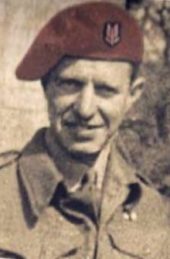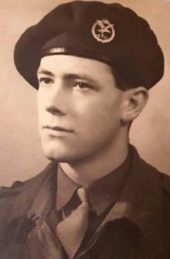Now and again the three men paused to listen, checking for any sign of enemy sentries, but the only sound apart from the occasional rustle of leaves was the beating of their own hearts. Though it was noticeably chilly, each of the raiders was sweating.
Vaculik made it to the first of the heaps. Kneeling down, he lifted one corner of the black sheeting, revealing huge stacks of landmines, bombs and 88mm shells. These shells had been piled up so locomotives could haul them north towards the beaches. As he peeled the thick tarpaulin back further, it crackled alarmingly, the noise sounding like gunshots, loud in the silence. For a moment Vaculik froze, convinced the guards must have heard, but there was no cry of alarm. He wiped the sweat from his brow before biting down hard on the delayed action timer. Each of their “timer pencil” fuses consisted of a brass tube, topped by a copper cap. Crushing that served to release acid into the tube, which ate away at its internal components, chiefly a steel wire that held a firing pin at the ready. The spring- loaded firing pin would then shoot down the tube, detonating the charge. If they’d got their sums right, they should take four hours to go off.
Fuse set, Vaculik thrust the charge deep into the heap of munitions. Instinctively he made the sign of the cross. He wouldn’t want to be within half a mile of the place when the explosions were triggered. As he crawled towards the next dark pile, Vaculik thought of his comrades. “They were all fine fellows,” he reflected, though of course “a mistake on someone’s part could blow us all to smithereens”.
On the way back to the rendezvous point, Vaculik ran into a shadowy figure. It was Paddy Barker. “How did it go?” Vaculik whispered. “Couldn’t have been better,” Barker replied, in his distinctive Irish tones. “Except I wanted to sneeze all the time. I must have got a cold or something.”
With their sabotage complete – 45 charges set on the ammo dump – the 12 SABU-70 raiders made their way towards a railway tunnel for the second part of the night’s mission: ambushing a German locomotive. Experience had taught the SAS there was little point in blowing up rail tracks. The locomotive driver would spot the break in the rails and make an emergency halt. So the Special Operations Executive ( SOE) had come up with an ingenious trick.
The “fog signal” was used on the railways to warn a train driver if a stop signal might be obscured. Consisting of a small metal bowl and a pressure plate, which clamped to the rail, they would detonate with a crack as the train went over them, warning the driver to slow.
The SOE’s version however triggered a detonation cord connected to a charge further ahead on the rails giving the driver no time to slow down. The locomotive would plough into the wrecked track at high speed, causing a catastrophic derailment.
With all present and correct, the 12 raiders made the their way towards the railway line. Now for the bloodiest work – taking out the sentries. The guards would have to be killed without a sound and that meant using the knife. As the minutes ticked by, Vaculik’s guts felt knotted up with anxiety and tension.
It was one thing shooting a man at a distance, quite another to slide in the blade at close quarters and feel the victim’s life blood ebb away. War, he figured, could be “a rotten thing”.
Loosening his knife in its sheath, Vaculik stole down the embankment. Up ahead his prey was whistling, keeping his back to Vaculik as he stomped his feet to keep warm. Killing done, stealthy figures swarmed onto the now unguarded tracks. Each rail was fitted with a pair of three- pound charges linked by detonation cord to fog signals clamped on top of the rails. Setting up their Bren guns in the long grass at the side of the embankment, they lay in wait. Exactly on time, the train burst into full view. Almost instantly there was a sharp crack and a blinding flash as the charges went off, and the locomotive seemed to be thrown into the air, ploughing up the embankment. Behind the engine, carriages buckled and telescoped into each other, in a deafening cacophony of noise. There was a momentary silence, before the cries of the wounded and roars of alarm cut the air, German soldiers trying to leap for safety. “Open fire!” Garstin yelled. Swathes of Bren fire tore into the wreckage, followed by a volley of grenades.
Suddenly, bursts of aimed fire stabbed out from the nearest patch of woodland. Whether it was enemy soldiers who had managed to evacuate the train, or guards manning the ammo dumps, the enemy was fighting back. “Get out now!” Garstin yelled. “Every man for himself!” Figures broke cover, dashing down the rail tracks as “Ginger” Jones stood resolute, Bren at the hip, ripping out bursts of fire to cover their escape.
It was 2.30am and they had three hours maximum before dawn and many miles on foot to reach the woodland where they would go to ground. They were alone and they expected to be ruthlessly hunted by an enemy hell-bent on vengeance. They set a punishing pace, fording rivers and crossing ploughed fields. They were soaked to the skin and exhausted by the time a massive blast erupted far behind, the ammo dumps going up with an almighty roar.
Finally, they reached their woodland hideout. With precious few explosives remaining, Garstin knew they would need to be extracted by the RAF. His second in command, John H Wiehe, managed to make contact with the UK – the SAS headquarters was then at Darvel, a town in East Ayrshire – to arrange their evacuation. The message back shocked him. “They’ve had the nerve to choose a Jerry airfield,” he told Garstin.
Etampes, south of Paris, boasted a complex of three airfields, home to a battlehardened Luftwaffe squadron. Incredibly this was where the RAF planned lo pick up the SABU-70 raiders. Two nights later, a recce of the airbase by Vaculik, Jones and Barker revealed a barbed wire perimeter fence and sentry posts with fake trees camouflaging a Ju-52 transport aircraft and an arms dump. More targets. The following night, with clouds covering the moon, the 12 raiders cut the barbed wire and crawled through. By 11.40pm, all their remaining explosive charges had been set and they crawled, weapons ready, towards the edge of the airstrip.
There was the distant rumble of an aircraft – it was their RAF pick-up 15 minutes early. “That’s not a plane,” someone whispered. “It’s a whole ruddy squadron!”
Suddenly the lights of the airbase were doused. Moments later the air was rent by anti-aircraft gunfire and explosions. The RAF was mounting a diversionary raid. At precisely midnight, Garstin fired a flare gun and three green flares sailed into the sky, unavoidably advertising their presence to an enemy already on high alert.
But this was it now: do or die. They waited with bated breath for some sign that their signal had been seen, that they had not been caught up in an Allied air raid simply by coincidence. Then, the unmistakable silhouette of a C-4 7 Dakota appeared out of the darkness. It swept low across their position, lined up with the runway, landed and taxied to a halt 100 yards from Garstin and his men. But as they got to their feet, several German Army trucks roared out of the darkness. Powerful headlamps nailed the C-4 7 and a machine gun opened fire. It was a sitting duck. The time for hiding was over.
“FIRE!” roared Garstin. “Stop them destroying the plane!” His last words were lost in a deafening blast as Jones levelled his trusty Bren and emptied an entire magazine into the lead vehicle. The truck’s headlamps erupted in a shower of shattered glass. Now they all sprinted toward the C-47. One by one the fugitives vaulted inside, ducking low through the doorway and into the welcoming am1s of the RAF aircrew. As machine gun fire chewed up the terrain around the aircraft, Jones cried out: “Paddy! Where are you?”
The warplane’s twin engines began to rev as the pilot prepared for take-off under fire but Jones dived out again. Moments later he was back, half-carrying, half-dragging the injured Paddy Barker, and the two men were hauled aboard. As the C-4 7 began to gain speed an enemy vehicle came tearing onto the strip. But the C-4 7 accelerated, lifting over the vehicle and into the night sky with all 12 raiders alive and on board. Enemy fire “splintered woodwork and ricocheted off metal” but the pilot roared away, turning for home. The men of SABU-70 would soon be back.
First published in the Daily Express in October 2020.






